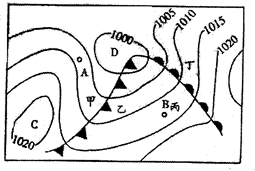分析某地的天气系统示意图,依次回答:(每空1分,共10分)

(1)图中的高低气压中心:C为 ,其天气情况: 。
(2)气流的垂直运动方向:D处 气流。
(3)比较A、B两点的气压值大小 ,A地偏 风,B地偏 风。(南或北)
比较A、B两点的风力大小 ,原因 。
(4)图中的冷、暖锋雨区位置:冷锋雨区位置在(甲乙丙丁中的) 地,暖锋雨区位置在(甲乙丙丁中的) 地。

本题考查等压线图示的综合分析。(1)直接根据图示的气压分布判断,C地中心气压较四周高,故判断为高压中心,中心盛行下沉气流,天气晴朗。(2)图示D处中心气压较四周低,故判断为低压中心,中心气流上升。(3)直接根据图示A、B两地的等压线位置可判断,A点气压低于B点,根据等压线分布可画出风向,风向斜穿等压线,由高压指向低压。A处等压线较B处密,故风力较大。(4)直接根据图示甲地的锋面性质进而判断两侧的气团性质,锋面雨区总在冷气团一般,不判断,冷锋雨区在甲处,暖锋雨区在丁处。
